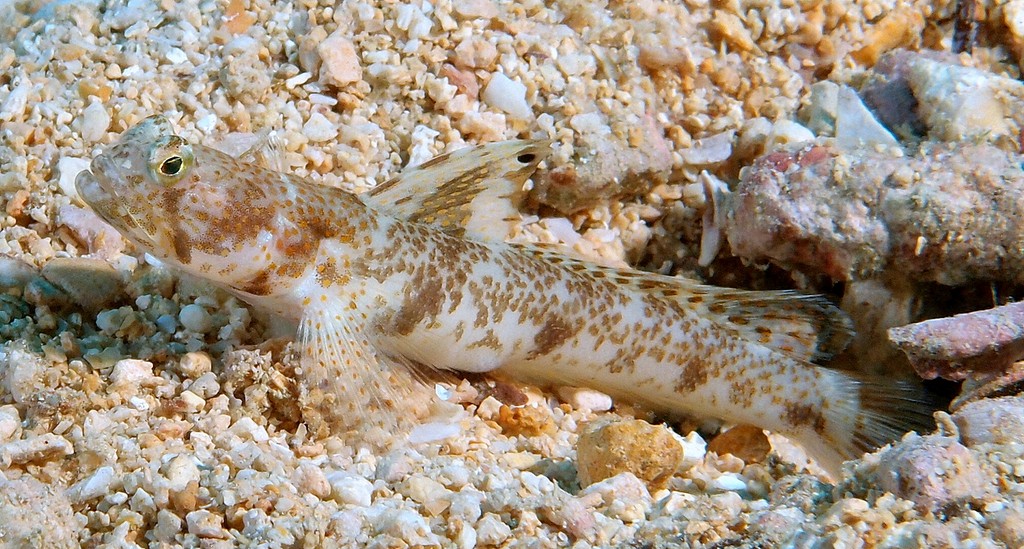TOMIYAMICHTHYS ONI - (TOMIYAMA, 1936)
Actinopterygii (Gigaclass) > Actinopteri (Class) > Teleostei (Subclass) > Gobiiformes (Order) > Gobioidei (Suborder) > Gobiidae (Family) > Gobiinae (Subfamily) > Tomiyamichthys (Genus)
Monster shrimpgoby, Mottled shrimp-goby, Oni-haze, オニハゼ, 富山鰕虎, 富山鰕虎魚,
Synonyme
Cryptocentrus oni (Tomiyama, 1936)
------------------------
Description
Dorsal spines (total): 6-7; Dorsal soft rays (total): 11; Anal spine: 1; Anal soft rays: 10-11. Triangular first dorsal fin without prolonged spines; United pelvic fins, well developed frenum present; Longitudinal scale series: 74-91; Head without scales; Body covered by cycloid scales; Greatest depth of body: 5.8-6.5 in SL; Rounded caudal fin, a little shorter than head length; Reduced posterior oculoscapular sensory canal, single pore (H') present. Max. length: 11.0 cm. Depth range: 10 - 30 m.
Color
Whitish body color; Presence of dark band below eye; Clusters of irregular brown spots covering body; 4-5 enlarged brown spots along ventral side; Several diffuse brown bars on side; Rear edge of dorsal fin with partially ocellated black spot; White coloration on basal portion of pectoral fin.
Etymology
Tomiyamichthys: in honor of ichthyologist (sometimes spelled Ichiro) Tomiyama (1906-1981), Tokyo Imperial University, who described type species, Tomiyamichthys oni, in 1936 + from Greek, ichthys = fish.
Oni: from japanese word, oni = demon, ogre, spirit of a deceased person.
Original description: Cryptocentrus oni Tomiyama, 1936 - Type locality: Tokyo fish market, thought to be from Izu, Shizuoka Prefecture, Japan.
Distribution
Monster shrimpgoby, Mottled shrimp-goby, Oni-haze, オニハゼ, 富山鰕虎, 富山鰕虎魚,
Synonyme
Cryptocentrus oni (Tomiyama, 1936)
------------------------
Description
Dorsal spines (total): 6-7; Dorsal soft rays (total): 11; Anal spine: 1; Anal soft rays: 10-11. Triangular first dorsal fin without prolonged spines; United pelvic fins, well developed frenum present; Longitudinal scale series: 74-91; Head without scales; Body covered by cycloid scales; Greatest depth of body: 5.8-6.5 in SL; Rounded caudal fin, a little shorter than head length; Reduced posterior oculoscapular sensory canal, single pore (H') present. Max. length: 11.0 cm. Depth range: 10 - 30 m.
Color
Whitish body color; Presence of dark band below eye; Clusters of irregular brown spots covering body; 4-5 enlarged brown spots along ventral side; Several diffuse brown bars on side; Rear edge of dorsal fin with partially ocellated black spot; White coloration on basal portion of pectoral fin.
Etymology
Tomiyamichthys: in honor of ichthyologist (sometimes spelled Ichiro) Tomiyama (1906-1981), Tokyo Imperial University, who described type species, Tomiyamichthys oni, in 1936 + from Greek, ichthys = fish.
Oni: from japanese word, oni = demon, ogre, spirit of a deceased person.
Original description: Cryptocentrus oni Tomiyama, 1936 - Type locality: Tokyo fish market, thought to be from Izu, Shizuoka Prefecture, Japan.
Distribution
Eastern Indian Ocean, western Pacific: Sumatra (Indonesia), east to Palau, north to central Japan, south to Papua New Guinea and New Caledonia.
Biology
Lives in clear coastal and inner reefs on rubble flats and slopes. Found in burrows together with Alpheus bellulus (Miya & Miyake, 1969).
Last update: 24, August 2024
Biology
Lives in clear coastal and inner reefs on rubble flats and slopes. Found in burrows together with Alpheus bellulus (Miya & Miyake, 1969).
Last update: 24, August 2024
